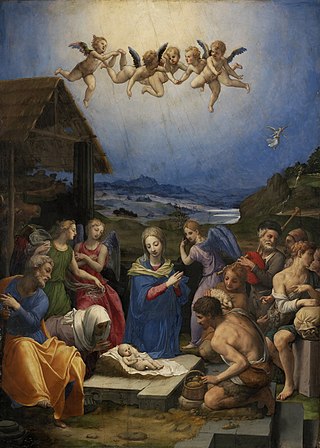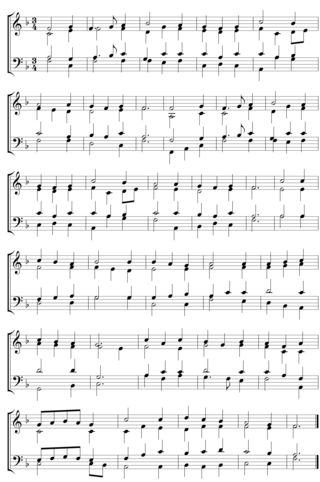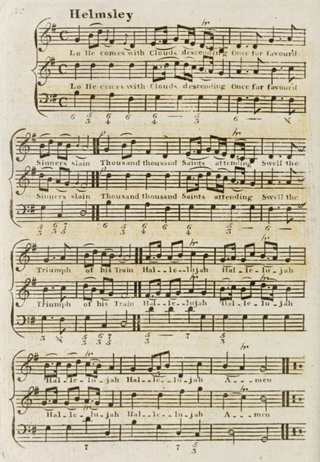A doxology is a short hymn of praises to God in various forms of Christian worship, often added to the end of canticles, psalms, and hymns. The tradition derives from a similar practice in the Jewish synagogue, where some version of the Kaddish serves to terminate each section of the service.

"O for a Thousand Tongues to Sing" is a Christian hymn written by Charles Wesley. The hymn was placed first in John Wesley's A Collection of Hymns for the People Called Methodists published in 1780. It was the first hymn in every (Wesleyan) Methodist hymnal from that time until the publication of Hymns and Psalms in 1983.
Alleluia is a phrase in Christianity used to give praise to God. In Christian worship, Alleluia is used as a liturgical chant in which that word is combined with verses of scripture, usually from the Psalms. This chant is commonly used before the proclamation of the Gospel. In Western Christianity, congregations commonly cease using the word Alleluia during the period of Lent but restore it into their services at Easter. The form of praise "Alleluia" is used by Christians to thank and glorify God; it finds itself present in many prayers and hymns, especially those related to Eastertide, such as "Christ the Lord is Risen Today".

"Hark! The Herald Angels Sing" is an English Christmas carol that first appeared in 1739 in the collection Hymns and Sacred Poems. The carol, based on Luke 2:8–14, tells of an angelic chorus singing praises to God. As it is known in the modern era, it features lyrical contributions from Charles Wesley and George Whitefield, two of the founding ministers of Methodism, with music adapted from "Vaterland, in deinen Gauen" of Felix Mendelssohn's cantata Festgesang.

"Christ the Lord Is Risen Today" is a Christian hymn associated with Easter. Most of the stanzas were written by Charles Wesley, and the hymn appeared under the title "Hymn for Easter Day" in Hymns and Sacred Poems by Charles and John Wesley in 1739. The hymn eventually became well known for the "Alleluia" sung as a melisma after each line, which was added by an unknown author, probably to fit the commonly used hymn tune, "Easter Hymn". It remains a traditional processional hymn on Easter Sunday.

"Rock of Ages" is a popular Christian hymn written by the Reformed Anglican minister Augustus Toplady.

"What Child Is This?" is a Christmas carol with lyrics written by William Chatterton Dix in 1865 and set to the tune of "Greensleeves", a traditional English folk song, in 1871. Although written in Great Britain, the carol today is more popular in the United States than its country of origin.

William Chatterton Dix was an English writer of hymns and carols. He was born in Bristol, the son of John Dix, a local surgeon, who wrote The Life of Chatterton the poet, a book of Pen Pictures of Popular English Preachers and other works. His father gave him his middle name in honour of Thomas Chatterton, a poet about whom he had written a biography. He was educated at the Grammar School, Bristol, for a mercantile career, and became manager of a maritime insurance company in Glasgow where he spent most of his life.

"Jesus Christ Is Risen Today" is a Christian hymn. It was initially written in the 14th century as a Bohemian Latin hymn titled "Surrexit Christus hodie". It is an Easter hymn referring to the Resurrection of Jesus and based on Matthew 28:6, Acts 2:32, 1 Peter 3:18 and Revelation 1:17-18.
Cwm Rhondda is a popular hymn tune written by John Hughes (1873–1932) in 1907. The name is taken from the Welsh name for the Rhondda Valley.

Hyfrydol is a Welsh hymn tune that appears in a number of Christian hymnals in various arrangements. Composed by Rowland Prichard, it was originally published in the composer's handbook to the children's songbook Cyfaill y Cantorion in 1844. Prichard composed the tune before he was twenty years old.
The Divine Service is a title given to the Eucharistic liturgy as used in the various Lutheran churches. It has its roots in the Pre-Tridentine Mass as revised by Martin Luther in his Formula missae of 1523 and his Deutsche Messe of 1526. It was further developed through the Kirchenordnungen of the sixteenth and seventeenth centuries that followed in Luther's tradition.

Rowland Huw Prichard was a Welsh musician. A native of Graienyn, near Bala, he lived most of his life in the area, serving for a time as a loom tender's assistant in Holywell, where he died. In 1844 Prichard published Cyfaill y Cantorion, a song book intended for children.
"For the Beauty of the Earth" is a Christian hymn by Folliott S. Pierpoint (1835-1917).

O filii et filiae is a Christian hymn celebrating Easter. It is attributed to Jean Tisserand, a Franciscan friar.
"Come Thou Almighty King" is a Christian hymn of unknown authorship, which is attributed to Charles Wesley by Victorian and Edwardian hymnologists, but whose authorship is predominantly stated as "anonymous" in modern hymnals.

"Lo! He comes with clouds descending" is a Christian hymn by Charles Wesley (1707–1788), based on an earlier hymn, "Lo! He cometh, countless Trumpets" by John Cennick (1718–1755). Most commonly sung at Advent, the hymn derives its theological content from the Book of Revelation relating imagery of the Day of Judgment. Considered one of the "Great Four Anglican Hymns" in the 19th century, it is most commonly sung to the tune Helmsley, first published in 1763.
"The Strife is O'er, the Battle Done" is a Christian hymn that is traditionally sung at Easter to celebrate the Resurrection of Jesus. It was originally a 17th-century Latin hymn, "Finita iam sunt proelia"; the popular English-language version is an 1861 translation by the English hymnwriter Francis Pott.
"Ye Choirs of New Jerusalem" or "Sing, Choirs of New Jerusalem" is an English Easter hymn by Robert Campbell. It is a 19th-century translation of the medieval Chorus novae Ierusalem, attributed to Fulbert of Chartres. The text's primary focus is the Resurrection of Jesus, taking the theme of Jesus as triumphant victor over death and deliverer of the prisoners from Hell.











